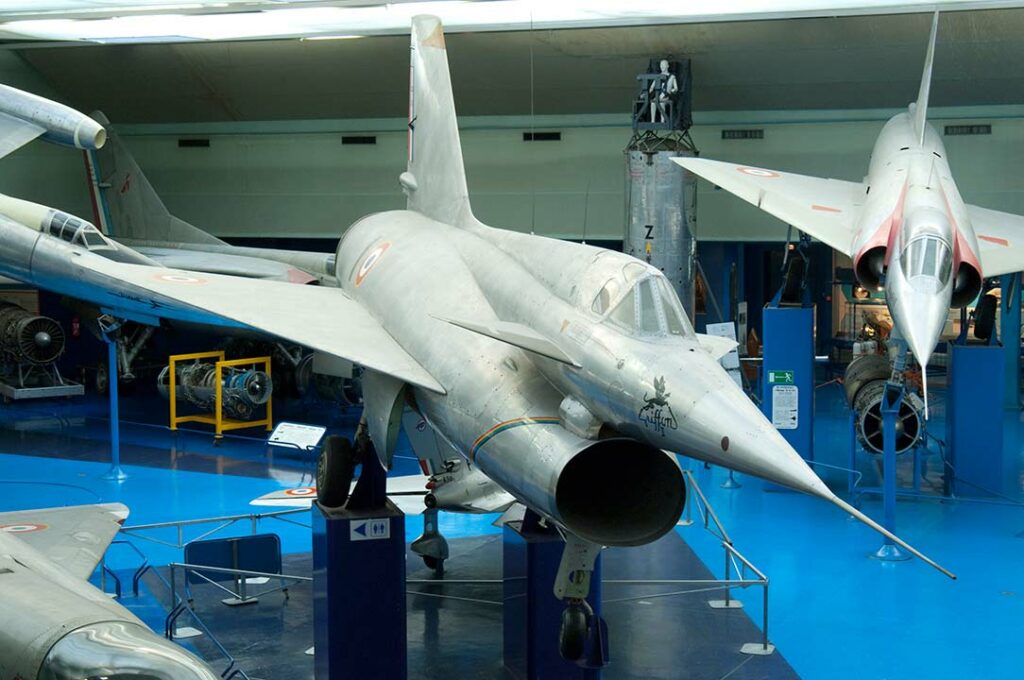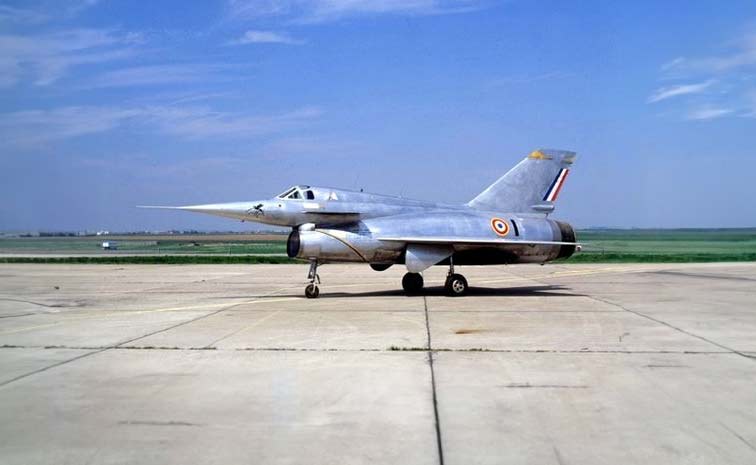French experimental interceptor, the Nord 1500 Griffon, featuring a unique turbojet-ramjet propulsion system for high-speed performance.
Technical Summary
The Nord 1500 Griffon was a remarkable experimental aircraft developed in France during the mid-20th century, aimed at exploring the limits of high-speed flight. It was distinguished by its innovative propulsion system that combined a turbojet engine with a ramjet, allowing it to achieve speeds that were unprecedented at the time. The aircraft had a distinctive design with a delta wing configuration, which was crucial for maintaining stability at high speeds. First flown in 1955, the Griffon demonstrated France’s technological prowess in aviation. It reached speeds over Mach 2, making it one of the fastest aircraft of its era. The dual propulsion system allowed for efficient operation across a wide range of speeds and altitudes, showcasing a significant advancement in aviation technology. Despite being an experimental platform, the Griffon’s achievements in speed and design influenced future aircraft development.
The Nord 1500 Griffon represents a significant chapter in the annals of experimental aviation, embodying the quest for speed and performance that characterized the Cold War era. This aircraft was not merely a technological marvel; it was a testament to the innovative spirit of its time, pushing the boundaries of what was possible in aerospace engineering.

History of the Development of the Nord 1500 (Griffon)
In the post-World War II era, the rapid advancement of aviation technology, fueled by the Cold War, necessitated the development of aircraft capable of superior performance, particularly in terms of speed and altitude. Against this backdrop, the French government sought to assert its presence on the global aerospace stage by commissioning an aircraft that could rival the best in the world. This ambition led to the inception of the Nord 1500 Griffon program.
Launched in the early 1950s by the French government and developed by Nord Aviation, the Griffon was a direct response to the need for a high-speed interceptor that could meet the challenges of the new age of supersonic flight. The program’s objective was clear: to create an aircraft that could achieve unprecedented speeds, leveraging the latest advancements in propulsion technology.
The Nord 1500 Griffon first took to the skies on September 20, 1955, marking a significant milestone in aviation history. This aircraft was not assigned a NATO nickname, as it was primarily an experimental and developmental project rather than a frontline military asset.
The development of the Griffon was indicative of the era’s technological optimism and the international race to achieve supersonic flight. It represented a significant investment in research and development, aiming to explore the potential of combined turbojet and ramjet propulsion systems—a concept that was revolutionary at the time.
The decision to pursue this innovative propulsion approach stemmed from the recognition that traditional turbojet engines alone could not provide the necessary speed and efficiency at higher altitudes and velocities. The Griffon’s design was therefore centered around a novel concept: a turbojet engine for takeoff, climb, and initial acceleration, coupled with a ramjet for sustained high-speed flight.
This experimental aircraft was not just a technological endeavor but also a symbol of national pride, showcasing France’s capability to innovate in the face of global competition. The development of the Griffon contributed significantly to the understanding of high-speed aerodynamics, propulsion, and the challenges of supersonic flight, laying the groundwork for future advancements in both military and civilian aviation.
Design of the Nord 1500 (Griffon)
The Nord 1500 Griffon was an embodiment of cutting-edge design and engineering, crafted to meet the demanding requirements of high-speed flight. Its architecture was a harmonious blend of form and function, optimized for performance at the edge of the aerospace envelope.
Central to the Griffon’s design was its propulsion system, a pioneering combination of a turbojet and a ramjet engine. This dual propulsion system allowed the aircraft to operate efficiently across a broad spectrum of speeds and altitudes. The turbojet engine facilitated takeoff, climb, and initial acceleration, while the ramjet provided the thrust necessary for sustained supersonic flight, propelling the Griffon to speeds beyond Mach 2.
The aircraft’s airframe was meticulously designed to withstand the rigors of high-speed flight. It featured a delta wing configuration, which was instrumental in ensuring stability and control at supersonic speeds. The delta wing also contributed to the Griffon’s distinctive appearance, setting it apart from its contemporaries.
In terms of dimensions, the Griffon was approximately 17 meters (55.8 feet) in length, with a wingspan of about 8.7 meters (28.5 feet). This compact and aerodynamic design was crucial for minimizing drag and maximizing speed. The aircraft’s weight and structural components were carefully calibrated to balance durability with performance, employing advanced materials and construction techniques of the time.
The advantages of the Griffon’s design were numerous. It demonstrated the feasibility of combining turbojet and ramjet propulsion, offering insights into high-speed aerodynamics that would influence future aircraft development. However, the complexity of its propulsion system also posed challenges, including the integration of two distinct engines and the transition between them during flight. These technical hurdles underscored the experimental nature of the Griffon, highlighting both its potential and its limitations as a platform for advancing aviation technology.
Ultimately, the Nord 1500 Griffon was a testament to innovation, embodying the spirit of exploration that defined the mid-20th century. Its design not only pushed the boundaries of speed and performance but also contributed valuable knowledge to the field of aerospace engineering, influencing subsequent generations of aircraft.
Performance of the Nord 1500 (Griffon)
The performance of the Nord 1500 Griffon was nothing short of extraordinary, setting new benchmarks for speed and efficiency in the realm of aviation. Powered by its unique turbojet-ramjet propulsion system, the Griffon achieved feats that were unparalleled at the time, firmly establishing its place in the annals of experimental aircraft.
The heart of the Griffon’s performance lay in its innovative propulsion configuration. The turbojet engine, responsible for takeoff and initial acceleration, seamlessly handed over to the ramjet as the aircraft reached higher speeds. This transition allowed the Griffon to accelerate to speeds exceeding Mach 2, with a reported top speed of over 2,200 kilometers per hour (1,367 miles per hour), a remarkable achievement that showcased the potential of combined propulsion technologies.
The aircraft’s altitude capabilities were equally impressive. It was designed to operate at high altitudes, with a service ceiling exceeding 18,000 meters (59,000 feet), further enhancing its performance characteristics. The ability to fly at such heights not only demonstrated the Griffon’s advanced aerodynamics but also its potential as a high-altitude interceptor, capable of engaging targets that were out of reach for many contemporary aircraft.
In terms of range, the Griffon’s operational flexibility was somewhat limited by its experimental nature and the fuel consumption characteristics of its propulsion system. However, the focus of its development was on speed and altitude performance, rather than long-distance flight.
When compared to its contemporaries, the Nord 1500 Griffon stood out for its speed and altitude capabilities. For instance, while the American Lockheed SR-71 Blackbird, developed around the same time, achieved higher speeds and altitudes, the Griffon’s achievements were remarkable for an aircraft of its era, particularly given its unique propulsion system.
The Griffon’s performance not only demonstrated the feasibility of combining turbojet and ramjet engines but also provided invaluable data on high-speed flight dynamics, propulsion efficiency, and the challenges associated with operating at the edge of the aerospace envelope. Despite its experimental status, the Griffon’s legacy is evident in the advancements it spurred in aviation technology, contributing to the development of faster, more capable aircraft in subsequent years.
Variants of the Nord 1500 (Griffon)
The Nord 1500 Griffon program produced several variants, each designed to explore different aspects of its groundbreaking propulsion system and aerodynamic capabilities. The primary variants included the Nord 1500-01 Griffon I and the Nord 1500-02 Griffon II, which were instrumental in the program’s experimental objectives.
The Griffon I was the initial prototype, designed to test the feasibility of the turbojet-ramjet propulsion system and to gather data on high-speed flight. It was equipped with a Turbomeca Marboré II turbojet engine for takeoff and climb, and a Nord Aviation ramjet for high-speed flight. This variant was pivotal in demonstrating the aircraft’s basic design and propulsion concepts, laying the foundation for further development.
The Griffon II, on the other hand, was an evolved version of the original design, featuring improvements in both the airframe and propulsion system. It was outfitted with a more powerful Atar turbojet engine, which enhanced its performance during the transition to ramjet-powered flight. The Griffon II achieved higher speeds and greater altitudes than its predecessor, setting records that underscored the potential of the aircraft’s innovative design.
Each variant of the Griffon contributed to the overall understanding of high-speed aerodynamics, propulsion integration, and the challenges associated with supersonic flight. The data gathered from these experimental aircraft provided invaluable insights that would influence future aircraft development, both in military and civilian aviation contexts.

Military Use and Combat of the Nord 1500 (Griffon)
The Nord 1500 Griffon, primarily an experimental aircraft, was not deployed in military operations or combat roles. Its development was focused on advancing aviation technology, particularly in the realms of speed, altitude, and propulsion systems. As such, the Griffon did not feature armaments or engage in military conflicts.
The primary purpose of the Griffon was to serve as a research platform, exploring the capabilities and limitations of high-speed flight. Its contributions to aviation were significant, providing critical data that would inform the design and development of future aircraft, both within France and internationally.
Although the Griffon did not see combat, its technological advancements had indirect military implications. The knowledge gained from its development helped to improve the performance and capabilities of subsequent military aircraft. By pushing the boundaries of speed and altitude, the Griffon played a role in shaping the specifications and expectations for future interceptor and reconnaissance platforms.
The Griffon’s legacy is not defined by battles fought or territories defended but by its contribution to the evolution of aviation technology. It showcased what was possible in the realm of high-speed, high-altitude flight, influencing the design and development of aircraft that would later serve in various military capacities around the world.
As experimental aircraft, the Griffon variants were not sold to other countries or used in active military service. Their value lay in the advancements they represented in aerospace engineering, serving as testbeds for technologies that would later be integrated into operational aircraft.
In conclusion, while the Nord 1500 Griffon did not participate in military operations, its impact on the field of aviation was profound. Through its development and testing, it contributed to a better understanding of supersonic flight, paving the way for future aircraft that would carry the mantle of innovation into both military and civilian aviation arenas.
The Nord 1500 Griffon stands as a testament to the innovative spirit and technical prowess of mid-20th-century aviation. Through its development, the Griffon explored the frontiers of speed and performance, contributing valuable insights into the challenges and potentials of supersonic flight. Its unique turbojet-ramjet propulsion system, coupled with its advanced aerodynamic design, pushed the boundaries of what was thought possible, influencing the development of future aircraft. While the Griffon may not have seen combat or widespread military use, its legacy lies in the technological advancements it spurred, shaping the future of aviation and demonstrating the enduring value of experimental research in pushing the envelope of aerospace engineering.
Back to the experimental aircraft section.